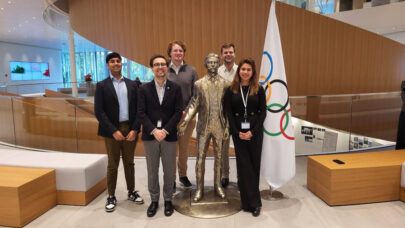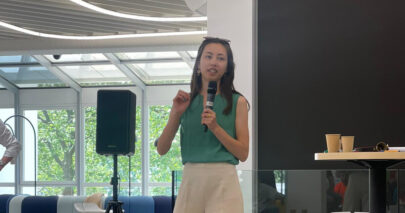
Is the world of businesses caught in a fury of hype around digital processes and transformations? According to IMD Professor Mike Wade, there is a lot of hype, but as the saying goes, “where there’s smoke there’s fire.”
A study from the Global Center for Digital Business Transformation, an IMD and Cisco initiative, found that roughly 4 of today’s top 10 market incumbents will be disrupted within the next 5 years. Examining 12 industries, the Center defined a digital vortex showing their vulnerability. Technology products and services, media and entertainment, retail and financial services, top the list of most vulnerable. Industries such as pharmaceuticals, oil & gas and utilities lie at the outer rims of the vortex, but are still vulnerable in the not so far future. “No industry is immune,” said Wade, Director of the Center. “Some have more time than others, but digital has changed perspective on strategy and every company must adapt to survive.”
The evolution of strategy
It used to be that strategy was fairly straight forward. Companies would determine their position, decide where the want to go, and make a plan to get there. But in the digital age, it’s increasingly impossible to determine where one wants to go. Things change too fast.
“Agility is the new differentiator in a business environment where strategy is becoming less relevant,” said Wade.
While according to the Center the keys to agility lie in hyperawareness, informed decision making and fast execution, IMD Professor Carlos Cordon said it’s also about a larger network.
“Companies must look beyond their industry to the ecosystem around them,” Cordon, who is author of the upcoming book Strategy is Digital, said. “Competitors may become partners, co-dependencies may develop and alliances may cross sectors.”
The new ecosystem of business
Pharmacies like Walgreens in the US and Medic in the Netherlands provide an example of this in taking on a greater role as caregiver. While they long had relationships only with doctors and clinics that sent clients, they are now finding new alliances (and revenue streams) with insurance companies, which have an interest in keeping people healthy.
Emma van Dijkum, Head of Borrower Product at Funding Circle, is on the same page. “Frenemies,” a fusion of friend and enemy is how she envisions competitors. Operating in a world of online funding for small businesses, Funding Circle takes on some of the clients bigger banks aren’t able to handle.
“Though we compete with your high-street banks, we are still a relatively small fish – but a very agile one that can offer quick responses, which often leads us to make relationships and partnerships with banks to serve a segment that they cannot.”
And likewise for Dressipi, a company that creates a unique “Fashion Fingerprint” for customers to give stylists personalized recommendations, competitors are collaborative.
“Building recommendations for fashion is deeply dynamic and involves a number of lifestyle changes as well as personal preferences,” said Sarah McVitte, the company’s co-founder and CEO. “In order to deliver the best, most relevant recommendations, collaboration with brands, high-street fashion and other players is key.”
Other than the environmental ecosystem, Professor Cordon also notes a change in the path to CEO and high-level positions. Today we are seeing many senior leaders come from digital backgrounds. And digital savvy millennials seem more sought after than ever. But that may be a matter of perspective.
Innovation and Millennials
Pau Garcia-Milà, a famed entrepreneur, founder of IdeaFoster and millennial born in 1987, reminds business leaders that millennials don’t have all the answers and can’t fix all the problems. In fact, being a millennial does not necessarily mean being talented and being an innovator: a millennial can be a criminal or a junkie! So screen well if your company believes youth is the answer.
For Garcia-Milà, innovation is a focus area in digital transformation. “In today’s world innovation is no longer about simply creating; it is about mixing things together in a revolutionary way.”
But the problem with innovation is often the societal barriers which discourage it. Gathering feedback from his own entrepreneurial endeavours, he found you can only be ‘lucky.’ And before you are ‘lucky,’ everyone will only warn of failure – which can and does happen. So either you fail or you get lucky, but success isn’t really an attitude that easily comes with digital innovation.
For Instagram, Brand Development Lead Gord Ray said a lot about innovation has to do with a company’s culture. “Smaller teams seem to lead to more innovation and less barriers in non-traditional cultures are key.”
Instagram, which is part of the Facebook family, is dolling up new ways for businesses of all sizes to market to consumers through mobile technology. Though once again Ray sees differences in how larger more traditional companies adapt in comparison to young small players and newly formed startups.
“The amount of time people spend on a mobile device is far greater than the amount of time and marketing resources larger companies dedicate to mobile,” Ray said. “But the newcomers in an industry usually don’t hesitate. They move extremely fast and naturally think ‘mobile first’.” Like with Facebook, entry to advertising through the Instagram platform isn’t restricted to any minimum spends. Anyone can do it and losses are minimal in trying.
But some larger companies are changing their culture. And one large company in particular, Cisco, is helping other companies change as well through the concept of smart buildings with ‘digital ceilings.’
The digital ceiling above
According to John Baekelmans, CTO of the Internet of Things and Digital Transformation at Cisco, the future workplace is one with no assigned office space and uniform utilities such as lighting and air. Through revolutionary apps, employees will be empowered to select the office space most appropriate for their needs and then adjust lighting, temperature and other features according to their preferences.
“What we are putting forward are systems for new workforce experiences that are energy efficient and tailored for predefined tasks,” Baekelmans said. “It’s important to distinguish that these changes, while technology enabled, aren’t about changing the technology of a building. They are about the experience of people in a building.”
While ‘digital ceilings’ may be the way forward for companies with bricks and mortar, there are others out there that question the need of physical space altogether.
Carlos Sanchez, CEO and Founder of ipagoo, a digital bank devoted to every-day banking services, questions the need for so many buildings in his sector.
“Currently there are over 8,000 banks in Europe and there are barriers for companies to bank from one country to the next in the need to establish physical presence. This is something that soon will no longer be necessary,” Sanchez said. “In the future I foresee that not every country will even have their own banks, they will affix with larger, more effective networks that will no longer be defined based on physical presence.”
While the idea of barrier-free banking could facilitate many businesses, traditional banks are not so convinced.
Disruption is inevitable
“There’s a tension between new and old. Banks feel something is being taken away from them and are reluctant to work with us,” Sanchez said. “Nobody wants to disenfranchise themselves, and the consequence of resistance to change will be disruption.”
Theirry Maupilé, Head of the Strategic Ecosystem Group, Strategy Office at Cisco also sees the necessity of disruption, and makes it part of business.
“Today we have to disrupt ourselves, compare notes with competitors, learn from the best and be nimble,” he said. “And tensions can be on the outside as well as internal, we have to be ready to accept that and live by an innovation everywhere principal.”
The bigger picture
Yet while there is much to be said about digital transformation, and much to look forward to in advances to come, Unilever CEO Paul Polman, reminded business leaders that digitalization isn’t the only priority.
“Individuals change course, not technology. While they may adopt technology, it will still be people and leadership that set the course of our future.”
Setting digital hype aside, Polman emphasized the social impact organizations have on the world and the fragile state of our global climate. Poverty, disease, war and uncertainty are factors that affect a greater part of the world.
“It is important to take a step back and look at the global trends that affect us,” Polman said. “If companies want to survive, they must make positive contributions to the world’s problems.”
Learn more about IMD’s program Leading Digital Business Transformation, given in Lausanne and Singapore.



